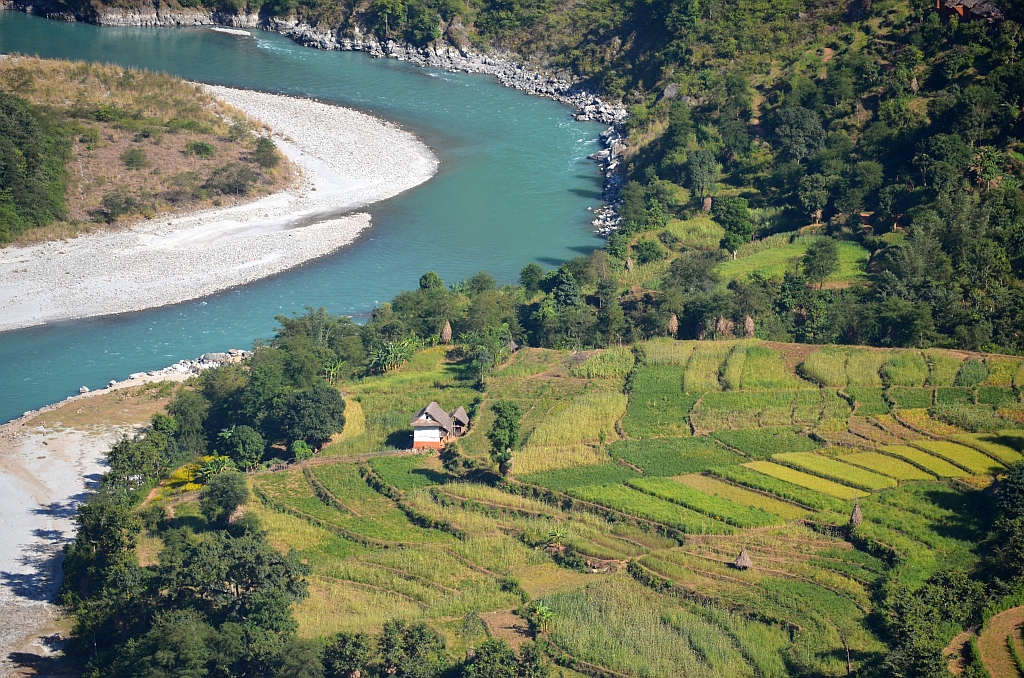New information on water resources to guide development in Nepal’s Koshi Basin
By Luna Bharati, Principal Research; Sanita Dhaubanjar, Research Officer; and Claire Swingle, Princeton in Asia Fellow, all with IWMI-Nepal

For decades, the development of water resources has been touted as Nepal’s “ticket out of poverty.” Almost all of the country’s sectoral and nationwide master plans have envisioned a substantial role for hydropower and irrigation, and the Koshi River Basin offers no exception. One key prerequisite for planning and developing the necessary infrastructure is a baseline assessment of the basin’s water resources. This involves generating information on how much water is available, when and where, considering historical as well as future climate conditions.
Conducting such an assessment in the Koshi Basin is complicated by the scarcity of long-term, good quality hydrological and climate data (and sometimes limited access to the data). A further problem is that current efforts to collect hydro-climatic data lack rigorous quality controls. The basin’s complex topography and diverse climate also make it difficult for scientists to construct hydrological and climatic sequences that capture variation over space and time.
In an effort to overcome these obstacles, researchers with the International Water Management Institute (IWMI) conducted a hydrological study (reported in IWMI Working Paper 187). Forming part of the CGIAR Research Program on Water, Land and Ecosystems (WLE), the study created a new dataset to assess the spatial and temporal water balances of the Koshi Basin in China, Nepal and India. Building on a previous IWMI study in this basin, which was limited to the mountain and hill regions of China and Nepal, the new model covers the Indo-Gangetic Plains downstream, where the Koshi joins the Ganges in India.
The study also incorporates additional data from diverse sources. To simulate future climate in the region, for example, the researchers downscaled the latest global climate model projections from the Intergovernmental Panel on Climate Change (IPCC) for eight different climate scenarios. Since flow and hydrological data from India or China are not publicly available, the model was validated at five hydrological stations in Nepal.
Over 75% of the rainfall and flow in the basin occurs during the monsoon season, and about 65% of annual rainfall is directly available in the form of river flows. Future monsoons are projected to be stronger and wetter, translating into higher river flows and increased flood risk, while future dry seasons will remain relatively unchanged. There is a clear mismatch between water availability and demand. Water availability is highest in the mountains but lowest in the Indo-Gangetic Plains, where demand is highest from agriculture and forests. It is extremely important for water management planners to take into account such differences between where and when water is available, compared to where and when it is needed.
The Koshi River is already known as the “sorrow of Bihar” because of its role in recurrent floods, which wash away farmland every year and claim the lives of thousands of people as well as livestock in the downstream regions. IWMI’s analysis shows that extreme flows currently happen two to five times a year. Such disasters will become worse, since both average and maximum monsoon flows are expected to be stronger than in the past, increasing the incidence of flooding and landslides. In future basin planning, disaster preparedness and flood risk management must therefore receive high priority.
IWMI’s new model offers the most comprehensive resource to date for guiding development of the Koshi Basin in light of an uncertain future climate. The Department of Irrigation of the Government of Nepal has already adopted the model in developing its National Irrigation Master Plan. Currently under review by various provincial governments and expected to come into effect in July 2019, the plan will set provincial irrigation and water management priorities for the next 25 years. Mainstreaming state-of-the-art hydrological models and novel hydro-climatic datasets is key for ensuring evidence-based policy and planning in the basins of Nepal and throughout the Global South.
Read the report:
Bharati, L.; Bhattarai, U.; Khadka, A.; Gurung, P.; Neumann, L. E.; Penton, D. J.; Dhaubanjar, S.; Nepal, S. 2019. From the mountains to the plains: impact of climate change on water resources in the Koshi River Basin. Colombo, Sri Lanka: International Water Management Institute (IWMI). 49p. (IWMI Working Paper 187). [doi: 10.5337/2019.205]

